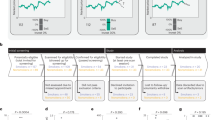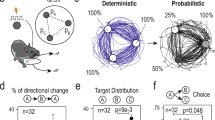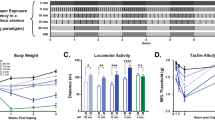Abstract
Nicotine dependence is a chronic mental illness that is characterized by a negative affective state upon tobacco smoking cessation and relapse after periods of abstinence. It has been hypothesized that cessation of nicotine administration results in the activation of brain corticotropin-releasing factor (CRF) systems that leads to the negative affective state of withdrawal. The aim of our experiments was to investigate the role of brain CRF systems in the deficit in brain reward function associated with the cessation of nicotine administration in rats. The intracranial self-stimulation procedure was used to assess to negative affective aspects of nicotine withdrawal as this procedure can provide a quantitative measure of emotional distress in rats. In the first experiment, mecamylamine induced a dose-dependent elevation in brain reward thresholds in nicotine-treated rats. In the follow-up experiment, it was shown that pretreatment with the corticotropin-receptor antagonist D-Phe CRF(12–41) prevents the elevations in brain reward thresholds associated with precipitated nicotine withdrawal. In the third experiment, the effect of D-Phe CRF(12–41) on the elevations in brain reward thresholds associated with spontaneous nicotine withdrawal was investigated. Administration of D-Phe CRF(12–41) 6 h after the explantation of the nicotine pumps, did not result in a lowering of the brain reward thresholds. These findings indicate that antagonism of CRF receptors prevents, but not reverses, the deficit in brain associated with nicotine withdrawal. These data provide support for the hypothesis that a hyperactivity of brain CRF systems may at least partly mediate the initiation of the negative affective aspects of nicotine withdrawal.
Similar content being viewed by others
Log in or create a free account to read this content
Gain free access to this article, as well as selected content from this journal and more on nature.com
or
References
American Psychiatric Association (2000). Diagnostic and Statistical Manual of Mental Disorders. American Psychiatric Press: Washington, DC.
Baldwin HA, Rassnick S, Rivier J, Koob GF, Britton KT (1991). CRF antagonist reverses the ‘anxiogenic’ response to ethanol withdrawal in the rat. Psychopharmacology (Berlin) 103: 227–232.
Bardo MT, Green TA, Crooks PA, Dwoskin LP (1999). Nornicotine is self-administered intravenously by rats. Psychopharmacology (Berlin) 146: 290–296.
Barr AM, Markou A (2005). Psychostimulant withdrawal as an inducing condition in animal models of depression. Neurosci Biobehav Rev 29: 675–706.
Basso AM, Spina M, Rivier J, Vale W, Koob GF (1999). Corticotropin-releasing factor antagonist attenuates the ‘anxiogenic-like’ effect in the defensive burying paradigm but not in the elevated plus-maze following chronic cocaine in rats. Psychopharmacology (Berlin) 145: 21–30.
Bruijnzeel AW, Gold MS (2005). The role of corticotropin-releasing factor-like peptides in cannabis, nicotine, and alcohol dependence. Brain Res Brain Res Rev 49: 505–528.
Bruijnzeel AW, Lewis B, Bajpai LK, Morey TE, Dennis DM, Gold M (2006). Severe deficit in brain reward function associated with fentanyl withdrawal in rats. Biol Psychiatry 59: 477–480.
Bruijnzeel AW, Markou A (2004). Adaptations in cholinergic transmission in the ventral tegmental area associated with the affective signs of nicotine withdrawal in rats. Neuropharmacology 47: 572–579.
Bruijnzeel AW, Markou A (2005). Decreased sensitivity to the effects of dopamine D1-like, but not D2-like, receptor antagonism in the posterior hypothalamic region/anterior ventral tegmental area on brain reward function during chronic exposure to nicotine in rats. Brain Res 1058: 91–100.
Corrigall WA, Coen KM (1989). Nicotine maintains robust self-administration in rats on a limited-access schedule. Psychopharmacology (Berlin) 99: 473–478.
Corrigall WA, Coen KM, Adamson KL (1994). Self-administered nicotine activates the mesolimbic dopamine system through the ventral tegmental area. Brain Res 653: 278–284.
Crooks PA, Dwoskin LP (1997). Contribution of CNS nicotine metabolites to the neuropharmacological effects of nicotine and tobacco smoking. Biochem Pharmacol 54: 743–753.
De Bellis MD, Gold PW, Geracioti Jr TD, Listwak SJ, Kling MA (1993). Association of fluoxetine treatment with reductions in CSF concentrations of corticotropin-releasing hormone and arginine vasopressin in patients with major depression. Am J Psychiatry 150: 656–657.
De Groote L, Penalva RG, Flachskamm C, Reul JM, Linthorst AC (2005). Differential monoaminergic, neuroendocrine and behavioural responses after central administration of corticotropin-releasing factor receptor type 1 and type 2 agonists. J Neurochem 94: 45–56.
Debruyne D, Sobrio F, Hinschberger A, Camsonne R, Coquerel A, Barre L (2003). Short-term pharmacokinetics and brain distribution of mecamylamine as a preliminary to carbon-11 labeling for nicotinic receptor investigation. J Pharm Sci 92: 1051–1057.
Donny EC, Caggiula AR, Mielke MM, Booth S, Gharib MA, Hoffman A et al (1999). Nicotine self-administration in rats on a progressive ratio schedule of reinforcement. Psychopharmacology (Berlin) 147: 135–142.
Dunn AJ, Swiergiel AH, Palamarchouk V (2004). Brain circuits involved in corticotropin-releasing factor-norepinephrine interactions during stress. Ann NY Acad Sci 1018: 25–34.
Epping-Jordan MP, Watkins SS, Koob GF, Markou A (1998). Dramatic decreases in brain reward function during nicotine withdrawal. Nature 393: 76–79.
Harrison AA, Liem YT, Markou A (2001). Fluoxetine combined with a serotonin-1A receptor antagonist reversed reward deficits observed during nicotine and amphetamine withdrawal in rats. Neuropsychopharmacology 25: 55–71.
Heinrichs SC, Menzaghi F, Schulteis G, Koob GF, Stinus L (1995). Suppression of corticotropin-releasing factor in the amygdala attenuates aversive consequences of morphine withdrawal. Behav Pharmacol 6: 74–80.
Koob GF (1999). Corticotropin-releasing factor, norepinephrine, and stress. Biol Psychiatry 46: 1167–1180.
Koob GF, Caine SB, Parsons L, Markou A, Weiss F (1997). Opponent process model and psychostimulant addiction. Pharmacol Biochem Behav 57: 513–521.
Koob GF, Le Moal M (2005). Plasticity of reward neurocircuitry and the ‘dark side’ of drug addiction. Nat Neurosci 8: 1442–1444.
Kornetsky C, Esposito RU (1979). Euphorigenic drugs: effects on the reward pathways of the brain. Fed Proc 38: 2473–2476.
Lavicky J, Dunn AJ (1993). Corticotropin-releasing factor stimulates catecholamine release in hypothalamus and prefrontal cortex in freely moving rats as assessed by microdialysis. J Neurochem 60: 602–612.
Le AD, Harding S, Juzytsch W, Watchus J, Shalev U, Shaham Y (2000). The role of corticotrophin-releasing factor in stress-induced relapse to alcohol-seeking behavior in rats. Psychopharmacology (Berlin) 150: 317–324.
Macey DJ, Koob GF, Markou A (2000). CRF and urocortin decreased brain stimulation reward in the rat: reversal by a CRF receptor antagonist. Brain Res 866: 82–91.
Malin DH, Lake JR, Newlin-Maultsby P, Roberts LK, Lanier JG, Carter VA et al (1992). Rodent model of nicotine abstinence syndrome. Pharmacol Biochem Behav 43: 779–784.
Markou A, Kosten TR, Koob GF (1998). Neurobiological similarities in depression and drug dependence: a self-medication hypothesis. Neuropsychopharmacology 18: 135–174.
McLellan AT, Lewis DC, O'Brien CP, Kleber HD (2000). Drug dependence, a chronic medical illness: implications for treatment, insurance, and outcomes evaluation. JAMA 284: 1689–1695.
Merali Z, Du L, Hrdina P, Palkovits M, Faludi G, Poulter MO et al (2004). Dysregulation in the suicide brain: mRNA expression of corticotropin-releasing hormone receptors and GABA(A) receptor subunits in frontal cortical brain region. J Neurosci 24: 1478–1485.
Merlo Pich E, Lorang M, Yeganeh M, Rodriguez de Fonseca F, Raber J, Koob GF et al (1995). Increase of extracellular corticotropin-releasing factor-like immunoreactivity levels in the amygdala of awake rats during restraint stress and ethanol withdrawal as measured by microdialysis. J Neurosci 15: 5439–5447.
Nemeroff CB, Bissette G, Akil H, Fink M (1991). Neuropeptide concentrations in the cerebrospinal fluid of depressed patients treated with electroconvulsive therapy. Corticotrophin-releasing factor, beta-endorphin and somatostatin. Br J Psychiatry 158: 59–63.
Nemeroff CB, Widerlov E, Bissette G, Walleus H, Karlsson I, Eklund K et al (1984). Elevated concentrations of CSF corticotropin-releasing factor-like immunoreactivity in depressed patients. Science 226: 1342–1344.
O'Brien CP (2003). Research advances in the understanding and treatment of addiction. Am J Addict 12 (Suppl 2): S36–S47.
Olive MF, Koenig HN, Nannini MA, Hodge CW (2002). Elevated extracellular CRF levels in the bed nucleus of the stria terminalis during ethanol withdrawal and reduction by subsequent ethanol intake. Pharmacol Biochem Behav 72: 213–220.
Overstreet DH, Knapp DJ, Breese GR (2004). Modulation of multiple ethanol withdrawal-induced anxiety-like behavior by CRF and CRF1 receptors. Pharmacol Biochem Behav 77: 405–413.
Paxinos G, Watson C (1998). The Rat Brain in Stereotaxic Coordinates. Academic Press: San Diego.
Picciotto MR, Zoli M, Rimondini R, Lena C, Marubio LM, Merlo Pich E et al (1998). Acetylcholine receptors containing the beta2 subunit are involved in the reinforcing properties of nicotine. Nature 391: 173–177.
Price ML, Lucki I (2001). Regulation of serotonin release in the lateral septum and striatum by corticotropin-releasing factor. J Neurosci 21: 2833–2841.
Rassnick S, Heinrichs SC, Britton KT, Koob GF (1993). Microinjection of a corticotropin-releasing factor antagonist into the central nucleus of the amygdala reverses anxiogenic-like effects of ethanol withdrawal. Brain Res 605: 25–32.
Richter RM, Weiss F (1999). In vivo CRF release in rat amygdala is increased during cocaine withdrawal in self-administering rats. Synapse 32: 254–261.
Rodriguez de Fonseca F, Carrera MR, Navarro M, Koob GF, Weiss F (1997). Activation of corticotropin-releasing factor in the limbic system during cannabinoid withdrawal. Science 276: 2050–2054.
Sarnyai Z, Biro E, Gardi J, Vecsernyes M, Julesz J, Telegdy G (1995). Brain corticotropin-releasing factor mediates ‘anxiety-like’ behavior induced by cocaine withdrawal in rats. Brain Res 675: 89–97.
Schulteis G, Markou A, Cole M, Koob GF (1995). Decreased brain reward produced by ethanol withdrawal. Proc Natl Acad Sci USA 92: 5880–5884.
Shimizu H, Bray GA (1989). Modulation by corticotropin-releasing factor of monoamine metabolism in the lateral hypothalamus. Neurosci Lett 103: 74–80.
Stinus L, Cador M, Zorrilla EP, Koob GF (2005). Buprenorphine and a CRF1 antagonist block the acquisition of opiate withdrawal-induced conditioned place aversion in rats. Neuropsychopharmacology 30: 90–98.
Stolerman IP, Jarvis MJ (1995). The scientific case that nicotine is addictive. Psychopharmacology (Berlin) 117: 2–10.
Stout SC, Mortas P, Owens MJ, Nemeroff CB, Moreau J (2000). Increased corticotropin-releasing factor concentrations in the bed nucleus of the stria terminalis of anhedonic rats. Eur J Pharmacol 401: 39–46.
Valdez GR, Zorrilla EP, Roberts AJ, Koob GF (2003). Antagonism of corticotropin-releasing factor attenuates the enhanced responsiveness to stress observed during protracted ethanol abstinence. Alcohol 29: 55–60.
Veith RC, Lewis N, Langohr JI, Murburg MM, Ashleigh EA, Castillo S et al (1993). Effect of desipramine on cerebrospinal fluid concentrations of corticotropin-releasing factor in human subjects. Psychiatry Res 46: 1–8.
Watkins SS, Epping-Jordan MP, Koob GF, Markou A (1999). Blockade of nicotine self-administration with nicotinic antagonists in rats. Pharmacol Biochem Behav 62: 743–751.
Wise RA, Munn E (1995). Withdrawal from chronic amphetamine elevates baseline intracranial self-stimulation thresholds. Psychopharmacology (Berlin) 117: 130–136.
Zhang JJ, Swiergiel AH, Palamarchouk VS, Dunn AJ (1998). Intracerebroventricular infusion of CRF increases extracellular concentrations of norepinephrine in the hippocampus and cortex as determined by in vivo voltammetry. Brain Res Bull 47: 277–284.
Zobel AW, Nickel T, Kunzel HE, Ackl N, Sonntag A, Ising M et al (2000). Effects of the high-affinity corticotropin-releasing hormone receptor 1 antagonist R121919 in major depression: the first 20 patients treated. J Psychiatr Res 34: 171–181.
Acknowledgements
This work was funded by a National Institute on Drug Abuse grant (RO3 DA020502-01) to Adrie Bruijnzeel. Carrie Wilson received salary support from The University of Florida's College of Veterinary Medicine Merck-Merial Veterinary Scholars Program. We would like to thank Dr Jean Rivier (The Clayton Foundation Laboratories for Peptide Biology, the Salk Institute for Biological Studies, San Diego, CA) for generously providing D-Phe CRF(12–41).
Author information
Authors and Affiliations
Corresponding author
Rights and permissions
About this article
Cite this article
Bruijnzeel, A., Zislis, G., Wilson, C. et al. Antagonism of CRF Receptors Prevents the Deficit in Brain Reward Function Associated with Precipitated Nicotine Withdrawal in Rats. Neuropsychopharmacol 32, 955–963 (2007). https://doi.org/10.1038/sj.npp.1301192
Received:
Revised:
Accepted:
Published:
Issue date:
DOI: https://doi.org/10.1038/sj.npp.1301192
Keywords
This article is cited by
-
Antireward, compulsivity, and addiction: seminal contributions of Dr. Athina Markou to motivational dysregulation in addiction
Psychopharmacology (2017)
-
Neuropeptide systems and new treatments for nicotine addiction
Psychopharmacology (2017)
-
CRF-like receptor SEB-3 in sex-common interneurons potentiates stress handling and reproductive drive in C. elegans
Nature Communications (2016)
-
Targeting the Brain Stress Systems for the Treatment of Tobacco/Nicotine Dependence: Translating Preclinical and Clinical Findings
Current Addiction Reports (2016)
-
Reinforcer devaluation as a consequence of acute nicotine exposure and withdrawal
Psychopharmacology (2015)



